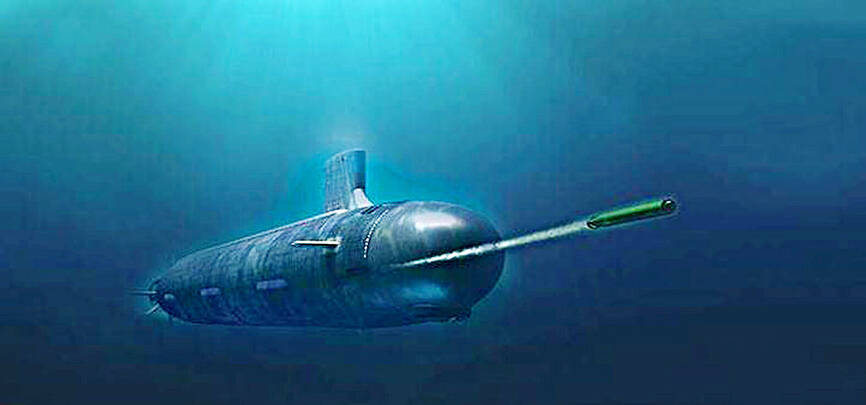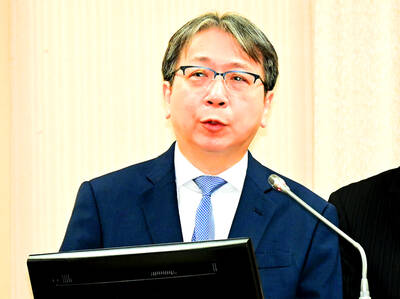Taiwan is to receive US-made Mark 48 torpedoes and training simulators over the next three years, following delays that hampered the navy’s operational readiness, the Ministry of National Defense’s latest budget proposal showed.
The navy next year would acquire four training simulator systems for the torpedoes and take receipt of 14 torpedoes in 2027 and 10 torpedoes in 2028, the ministry said in its budget for the next fiscal year.
The torpedoes would almost certainly be utilized in the navy’s two upgraded Chien Lung-class submarines and the indigenously developed Hai Kun, should the attack sub successfully reach operational status.

Photo courtesy of Raytheon Co
US President Donald Trump approved the sale of the torpedoes in June 2017 during his first term, with deliveries planned for this year and the next, but Washington was not able to keep the timetable.
The Mark 48 Mod 6 Advanced Technology heavyweight submarine-launched torpedoes, which cost NT$5.46 billion (US$178.4 million), are to provide the navy with a successor to its obsolescent SUT systems from Germany.
The Mark 48 torpedoes are acoustically homing systems featuring an all-digital guidance and control system and a 295kg high-explosive warhead, the US Navy said.
Experts estimate that the Mark 48 torpedoes have a maximum speed of 55 knots (102kph) and can achieve an effective range of 27 nautical miles (50km) cruising at 40 knots.
The weapon is a significant upgrade in speed, range, power and stealth for Taiwan’s submarine fleet, with its ability to break the keels of targeted ships frequently cited as an advantage over older designs.
The ministry’s budget proposal also listed NT$1.2 billion to buy Kestrel II anti-tank rockets over the next two years, more than doubling the budget allotted for last year and this year.
The increased budget for procuring ammunition for the Kestrel II anti-tank weapon systems indicates that the military is advancing with a force-wide replacement of license-produced M72 LAW launchers.
Another ministry report published in May revealed the military has expended 1,104 Kestrel rockets in target practice, corroborating previous reports that all service members would be trained to use the weapon.
The state-run Chungshan Institute of Science and Technology, which developed the Kestrel II, said that the weapon has an effective range of 400m and can penetrate armor equivalent to 300mm of rolled homogenous steel.
The primary role of the Kestrel weapon system is to achieve mobility kills against tanks and light armored vehicles by damaging their tracks or wheels, it said.
This performance is superior to the 200m effective firing range and 200mm of armor penetration of the license-produced M72s, while their per-unit price of NT$100,000 is cheaper than buying the upgraded M72A8 rockets from the US, the institute said last year.
An upgraded version of the Kestrel II system featuring soft-launch capability for firing inside structures, tandem-charge warheads to defeat explosive reactive armor, lighter-weight launchers and predicted-line-of-sight guidance is being developed, it said.
The product improvement program is expected to be completed before the year’s end, it added.
Weight reduction efforts have yielded a prototype that lightened the launcher tube to 5.1kg from 7.6kg, with the goal of fielding a weapon of less than 4kg, the institute said.
The indoor-firing capability utilizes an impact mitigation module to the rear of the launcher to moderate backblast flames and overpressure, it said.
Work on the feature began in April and performance is expected to meet operational requirements for infantry combat stipulated by the US Army Techniques Publication 3-21.8, it said.
An army spokesperson said the service is still assessing whether there is an operational need for tandem warheads in light anti-tank weapons.

The US government has signed defense cooperation agreements with Japan and the Philippines to boost the deterrence capabilities of countries in the first island chain, a report by the National Security Bureau (NSB) showed. The main countries on the first island chain include the two nations and Taiwan. The bureau is to present the report at a meeting of the legislature’s Foreign Affairs and National Defense Committee tomorrow. The US military has deployed Typhon missile systems to Japan’s Yamaguchi Prefecture and Zambales province in the Philippines during their joint military exercises. It has also installed NMESIS anti-ship systems in Japan’s Okinawa

‘WIN-WIN’: The Philippines, and central and eastern European countries are important potential drone cooperation partners, Minister of Foreign Affairs Lin Chia-lung said Minister of Foreign Affairs Lin Chia-lung (林佳龍) in an interview published yesterday confirmed that there are joint ventures between Taiwan and Poland in the drone industry. Lin made the remark in an exclusive interview with the Chinese-language Liberty Times (the Taipei Times’ sister paper). The government-backed Taiwan Excellence Drone International Business Opportunities Alliance and the Polish Chamber of Unmanned Systems on Wednesday last week signed a memorandum of understanding in Poland to develop a “non-China” supply chain for drones and work together on key technologies. Asked if Taiwan prioritized Poland among central and eastern European countries in drone collaboration, Lin

ON ALERT: Taiwan’s partners would issue warnings if China attempted to use Interpol to target Taiwanese, and the global body has mechanisms to prevent it, an official said China has stationed two to four people specializing in Taiwan affairs at its embassies in several democratic countries to monitor and harass Taiwanese, actions that the host nations would not tolerate, National Security Bureau (NSB) Director-General Tsai Ming-yen (蔡明彥) said yesterday. Tsai made the comments at a meeting of the legislature’s Foreign Affairs and National Defense Committee, which asked him and Minister of National Defense Wellington Koo (顧立雄) to report on potential conflicts in the Taiwan Strait and military preparedness. Democratic Progressive Party (DPP) Legislator Michelle Lin (林楚茵) expressed concern that Beijing has posted personnel from China’s Taiwan Affairs Office to its

BACK TO WORK? Prosecutors said they are considering filing an appeal, while the Hsinchu City Government said it has applied for Ann Kao’s reinstatement as mayor The High Court yesterday found suspended Hsinchu mayor Ann Kao (高虹安) not guilty of embezzling assistant fees, reducing her sentence to six months in prison commutable to a fine from seven years and four months. The verdict acquitted Kao of the corruption charge, but found her guilty of causing a public official to commit document forgery. The High Prosecutors’ Office said it is reviewing the ruling and considering whether to file an appeal. The Taipei District Court in July last year sentenced Kao to seven years and four months in prison, along with a four-year deprivation of civil rights, for contravening the Anti-Corruption